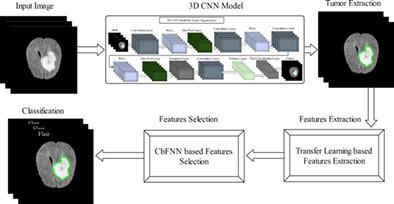当前位置:
X-MOL 学术
›
Microsc. Res. Tech.
›
论文详情
Our official English website, www.x-mol.net, welcomes your
feedback! (Note: you will need to create a separate account there.)
Microscopic brain tumor detection and classification using 3D CNN and feature selection architecture.
Microscopy Research and Technique ( IF 2.0 ) Pub Date : 2020-09-21 , DOI: 10.1002/jemt.23597 Amjad Rehman 1 , Muhammad Attique Khan 2 , Tanzila Saba 1 , Zahid Mehmood 3 , Usman Tariq 4 , Noor Ayesha 5
Microscopy Research and Technique ( IF 2.0 ) Pub Date : 2020-09-21 , DOI: 10.1002/jemt.23597 Amjad Rehman 1 , Muhammad Attique Khan 2 , Tanzila Saba 1 , Zahid Mehmood 3 , Usman Tariq 4 , Noor Ayesha 5
Affiliation

|
Brain tumor is one of the most dreadful natures of cancer and caused a huge number of deaths among kids and adults from the past few years. According to WHO standard, the 700,000 humans are being with a brain tumor and around 86,000 are diagnosed since 2019. While the total number of deaths due to brain tumors is 16,830 since 2019 and the average survival rate is 35%. Therefore, automated techniques are needed to grade brain tumors precisely from MRI scans. In this work, a new deep learning‐based method is proposed for microscopic brain tumor detection and tumor type classification. A 3D convolutional neural network (CNN) architecture is designed at the first step to extract brain tumor and extracted tumors are passed to a pretrained CNN model for feature extraction. The extracted features are transferred to the correlation‐based selection method and as the output, the best features are selected. These selected features are validated through feed‐forward neural network for final classification. Three BraTS datasets 2015, 2017, and 2018 are utilized for experiments, validation, and accomplished an accuracy of 98.32, 96.97, and 92.67%, respectively. A comparison with existing techniques shows the proposed design yields comparable accuracy.
中文翻译:

使用 3D CNN 和特征选择架构的显微脑肿瘤检测和分类。
脑肿瘤是癌症最可怕的性质之一,在过去几年中导致大量儿童和成人死亡。根据世界卫生组织的标准,70万人患有脑肿瘤,自2019年以来约有8.6万人被确诊。而自2019年以来,脑肿瘤导致的死亡总数为16,830人,平均存活率为35%。因此,需要自动化技术来从 MRI 扫描中精确地对脑肿瘤进行分级。在这项工作中,提出了一种新的基于深度学习的方法用于显微脑肿瘤检测和肿瘤类型分类。在第一步中设计了 3D 卷积神经网络 (CNN) 架构来提取脑肿瘤,并将提取的肿瘤传递给预训练的 CNN 模型进行特征提取。提取的特征被转移到基于相关的选择方法,作为输出,选择最好的特征。这些选定的特征通过前馈神经网络进行验证以进行最终分类。三个 BraTS 数据集 2015、2017 和 2018 用于实验和验证,准确率分别为 98.32、96.97 和 92.67%。与现有技术的比较表明,所提出的设计产生了可比较的准确性。
更新日期:2020-09-21
中文翻译:

使用 3D CNN 和特征选择架构的显微脑肿瘤检测和分类。
脑肿瘤是癌症最可怕的性质之一,在过去几年中导致大量儿童和成人死亡。根据世界卫生组织的标准,70万人患有脑肿瘤,自2019年以来约有8.6万人被确诊。而自2019年以来,脑肿瘤导致的死亡总数为16,830人,平均存活率为35%。因此,需要自动化技术来从 MRI 扫描中精确地对脑肿瘤进行分级。在这项工作中,提出了一种新的基于深度学习的方法用于显微脑肿瘤检测和肿瘤类型分类。在第一步中设计了 3D 卷积神经网络 (CNN) 架构来提取脑肿瘤,并将提取的肿瘤传递给预训练的 CNN 模型进行特征提取。提取的特征被转移到基于相关的选择方法,作为输出,选择最好的特征。这些选定的特征通过前馈神经网络进行验证以进行最终分类。三个 BraTS 数据集 2015、2017 和 2018 用于实验和验证,准确率分别为 98.32、96.97 和 92.67%。与现有技术的比较表明,所提出的设计产生了可比较的准确性。











































 京公网安备 11010802027423号
京公网安备 11010802027423号